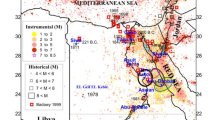Abstract
Seventy-five geotechnical boreholes were drilled in Jeddah city to identify the soil characteristics and calculate the shear wave velocity. The depth of boreholes extends up to 40 m in some sites, where the standard penetration test (SPT) was assigned at each 1.5 m depth interval. The groundwater table fluctuated between 0.5 and 9 m below the ground level. In addition, the multichannel analysis of surface waves (MASW) method was applied at the same borehole locations to estimate the shear wave velocity of the subsurface layers. 1D shear velocity profiles were processed using SeisImager software. The calculated shear wave velocity at the mid-point of each surveying line was compared with that of the borehole because the mid-point of the surveying line coincides with the borehole location. In addition, horizontal–vertical-spectral ratio inversion (INV_HVSR) of microtremor measurements recorded at the borehole locations represents a third method to estimate the shear wave velocity of subsurface layers. Results of these three methods are then compared and, finally, the average shear wave velocity values, up to a depth of 30 m, were assessed for Jeddah city. According to V s (30) values, the soil classes for Jeddah city can be classified into three classes as “site class D,” “site class C,” and “site class B,” according to the National Earthquake Hazard Reduction Program (NEHRP). These results should be added to the Saudi Building Code (SBC) to improve the requirements for the design of earthquake-resistant structures in Jeddah city.









Similar content being viewed by others
References
Anbazhagan P, Sitharam TG (2008) Site characterization and site response studies using shear wave velocity. Jsee 10(2):53–67
Bahafzullah A, Fayed LA, Al-Saify M (1993) Classification and distribution of the Red Sea coastal sabkhas near Jeddah – Saudi Arabia. Carbonates Evaporites 8(1):23–38
Borcherdt RD, Glassmoyer G (1994) ): Influences of local geology on strong and weak ground motions in the San Francisco Bay region and their implications for site-specific building-code provisions. In: Borcherdt, R.D. (ed.): The Loma Prieta, California, earthquake of 17 October 1989-strong ground motion. US Geological Survey Professional paper 1551:77–108
Boore DM (2004) Estimating Vs(30) (or NEHRP site classes) from shallow velocity models (depths <30 m). Bull Seism Soc Am 94(2):591–597
Boore DM, Joyner WB, Fumal TE (1993) Estimation of response spectra and peak acceleration from western north American earthquakes: an interim report. US Geological Survey Open-file Report 93-509:72 p
Building Seismic Safety Council, BSSC (2003) NEHRP Recommended provisions for new Buildings and Other Structures, FEMA:450
Dobry R, Borcherdt RD, Crouse CB, Idriss IM, Joyner WB, Martin GR, Power MS, Rinne EE, Seed RB (2000) New site coefficients and site classification system used in recent building seismic code provisions. Earthquake Spectra 16(1):41–67
El-Hady S, Fergany E, Othman A, Mohamed G (2012) Seismic microzonation of marsa alam, Egypt using inversion HVSR of microtremor observations. J Seismol 16:55–66. doi:10.1007/s10950-011-9249-4
Fumal TE (1978) Correlations between seismic wave velocities and physical properties of near-surface geologic materials in the southern San Francisco bay region. California US Geological Survey Open-File Report 78-1067:114 p
Fumal TE, Tinsley JC (1985) Mapping shear wave velocities of near-surface geological materials. In: J.I. Ziony, editor, predicting areal limits of earthquake induced landsliding; in evaluation of earthquake hazards in the Los Angeles region - an earth science perspective. US geol. Surv. Paper 1360:127–150
Herak M (2008) ModelHVSR-a matlab tool to model horizontal-to-vertical spectral ratio of ambient noise. Comput Geosci 34(11):1514–1526
International Code Council (2006): International Building Code: International Code Council, Inc., 666 p.
Joyner, W., and Fumal, T.E., (1984): Use of measured S-wave velocity for predicting geologic site effects on strong ground motion. Proceedings of the Eight World Conference on Earthquake Engineering, San Francisco, Calif., v. 2, p. 777–783.
Moore TA, Al-Rehaili MH (1989) Geologic map of the Makkah quadrangle, sheet 21D, Kingdom of Saudi Arabia, ministry of petroleum and mineral resources, deputy ministry for mineral resources publication. Jeddah, K.S.A.
Nakamura Y (1989) A method for dynamic characteristics estimation of subsurface using microtremor on the ground surface. QR of RTRI 30(1):25–33
Park CB, Miller RD, Xia J (1999) Multichannel analysis of surface waves. Geophysics, v 64(3):800–808
Park CB, Miller RD (2005) Seismic characterization of wind turbine sites near Lawton. Oklahoma, by the MASW Method: Kansas Geological Survey Open-File Report 2005-22
Sairam B (2011) Seismic site characterization using Vs30 and site amplification in gandhinagar region. Gujarat, India
Seed HB, Idriss IM, Arango I (1983) Evaluation of liquefaction potential using field performance data. J Geotech Eng 9(3):458–482
Sitharam TG, Anbazhagan P, Mahesh GU, Bharathi K, Nischala Reddy P (2005) Seismic hazard studies using geotechnical borehole data and GIS. Symposium on seismic hazard analysis and microzonation, Roorkee
Schmertmann JH, Hartmann JP, Brown PR (1978) Improved strain influence factor diagrams. J Geotech Eng Div ASCE 104(8):1131–1135
Scherbaum F, Hinzen K-G, Ohrnberger M (2003) Determination of shallow shear wave velocity profiles in the cologne/Germany area using ambient vibrations. Geophys J Int 152:597–612
Skempton AW (1986) Standard penetration test procedures and the effects in sands of overburden pressure, relative density, particle size, ageing and over-consolidation. Geotechnique 36(3):425–447
Xia J, Miller RD, Park CB (1999) Estimation of near-surface shear-wave velocity by inversion of Rayleigh waves. Geophysics 64(3):691–700
Wathelet M, Jongmans D, Ohrnberger M (2004) Surface-wave inversion using a direct search algorithm and its application to ambient vibration measurements. Near Surface Geophysics 211-221
Acknowledgments
This project was funded by the National Plan for Science, Technology and Innovation (MAARIFAH), King Abdulaziz City for Science and Technology (KACST), Kingdom of Saudi Arabia, Award Number (09 – INF 945-02).
Author information
Authors and Affiliations
Corresponding author
Rights and permissions
About this article
Cite this article
Al-Amri, A., Fnais, M., Abdelrahman, K. et al. New methods to improve the assessment of shear wave velocities and seismic hazard parameters in Jeddah city, western Saudi Arabia. Arab J Geosci 9, 220 (2016). https://doi.org/10.1007/s12517-015-2297-2
Received:
Accepted:
Published:
DOI: https://doi.org/10.1007/s12517-015-2297-2




